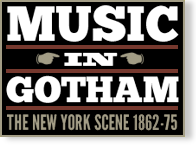Event Information
Venue(s):
Steinway Hall
Price: $1
Record Information
Status:
Published
Last Updated:
9 June 2024
Performance Date(s) and Time(s)
25 Apr 1872, EveningPerformers and/or Works Performed
Citations
“The annual concert of Mr. Bergner brought together a highly cultivated and appreciative audience. The selection was well adapted to show the powers of the various performers. Dr. Damrosch, both in Haydn’s quartet and Chopin’s nocturne, won loud applause for his exquisite performance on the violin. Master Kammerer, a pupil of Mr. Bergner, did credit to himself and teacher in the duet for two violoncellos. Miss Anna Simon and Mr. S. B. Mills added much to the pleasure of those present, the latter being loudly encored in his ‘Etude Caprice.’ Mr. Bergner deserves well of New Yorkers for his efforts in the cause of classical music, and the number of his friends increases every year.”
“The favorite violoncellist, Fred Bergner, who has been for many years one of the shining lights of the Philharmonic Society and who stands unrivalled as a ‘cello player, had a concert last night at this hall, in which he was assisted by [see above]. The concert opened with Haydn’s quartet in D, opus 64, for violins, viola and ‘cello, which was rendered with a precision and nicety of expression rarely heard in concerted pieces of this kind. Miss Simon sang an aria from ‘The Marriage of Figaro,’ and a song, ‘Frühlingslied,’ by Mendelssohn. Mr. Mills invested a Chopin impromptu, opus 66, with the delicacy and dreamy poetry it demanded, and followed it with an étude caprice by himself. Dr. Damrosch’s violin playing has become one of the most interesting and welcome pictures in a metropolitan concert, although we would prefer hearing him otherwise than in a transcription of a piano work of Chopin. The nocturne in B minor, opus 9, and the waltz, opus 42, which he selected, do not entirely depend on the melody for their effect. No instrument beside the piano can ever give them all their beauty and poetry. Bergner played Kummer’s Russian fantasia with his characteristic finish and breadth of tone, and concluded the concert by introducing for the first time in public a very young pupil of his, Master F. Kammerer, with whom he played a grand elegiac nocturne by Charles Schuberth. The new aspirant for public honors made a very promising début, and, considering what a trying instrument he has chosen, his success was remarkable. Firmness of tone and precision in execution are especially demanded for the ‘cello, and in these particulars Master Kammerer left nothing to be desired. And, in regard to this subject, we would advise other young men of musical proclivities to devote themselves to this instrument. It is always easy to find violinists and pianists in social circles, but when a trio or quartet of chamber music is desired—and, after all, what is more charming for the fireside—a violoncellist is scarcely attainable. The ‘cello is an instrument which is capable of giving expression to poetic sentiments which the violin knows nothing about, and it is the necessary complement of any musical venture in the regions of concerted works. With it one can enjoy Haydn, Mozart and Beethoven at their own firesides, fully as much as at a Philharmonic concert, and without it one has the violin and the piano alone for such works, like a house without a foundation. A good pianist and good violinist are always welcome and by no means scarce in this city, but the ‘cello is a rara avis in our salons, and yet it is as necessary as either of the other instruments. Therefore it should be cultivated some in this city, until each musical family can have a little orchestra of its own, as one may find elsewhere in Germany.”
“New York, May 11. Mr. F. Bergner’s Annual Concert, on the 25th of April, afforded the many friends of that excellent artist an opportunity of testifying their regard for him, which they did by coming out in force and filling Steinway’s smaller hall to its fullest capacity. The programme was attractive, and Mr. Bergner was assisted by the following artists [see above]. I give the programme [see above].
I need not say how well the difficult ‘Fantaise Russe’ was played by Mr. Bergner, whose broad, noble phrasing and fine intonation were never more manifest. The Quartet was played with excellent effect, and Dr. Damrosch gave a skillful rendering of Chopin’s Nocturne and Valse, transcribed for the violin, but he would do well to remember that Chopin is par excellence the poet of the piano, and that any attempt to improve upon his compositions by transcribing them for another instrument is not likely to be crowned with success.
Mr. Mills gave us a really fine rendering of Chopin’s Impromptu; but, if he must place his own Etude in such juxtaposition, why not play that first and the Chopin Impromptu afterwards.”

